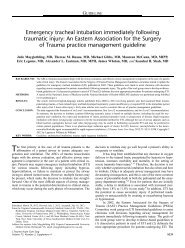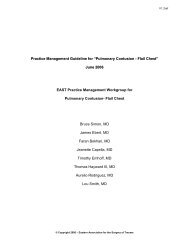Management of pulmonary contusion and flail chest - The Eastern ...
Management of pulmonary contusion and flail chest - The Eastern ...
Management of pulmonary contusion and flail chest - The Eastern ...
You also want an ePaper? Increase the reach of your titles
YUMPU automatically turns print PDFs into web optimized ePapers that Google loves.
Simon et al.<br />
multidisciplinary clinical pathway for rib fracture management.<br />
Patients <strong>of</strong> age greater than 45 years with four-rib or more rib<br />
fractures were identified <strong>and</strong> monitored early on. Analog pain<br />
scale greater than 6, incentive spirometry less than 15 mL/kg,<br />
<strong>and</strong> subjective assessment <strong>of</strong> weak cough triggered an aggressive<br />
multidisciplinary treatment by nursing, pain service,<br />
<strong>and</strong> respiratory therapy. This prospective Level II study used<br />
historical controls (n = 150 in each limb) but showed a very<br />
significant decrease in ICU <strong>and</strong> hospital LOS (p G 0.02) <strong>and</strong><br />
in incidence <strong>of</strong> pneumonia (p G 0.001) <strong>The</strong>re was a trend toward<br />
decreased mortality. This study was well powered <strong>and</strong><br />
gave Level II validity to what is empirically known, that early<br />
use <strong>of</strong> aggressive, attentive care for select patients will improve<br />
outcomes.<br />
Newer Modalities <strong>of</strong> Pain Control<br />
<strong>The</strong> options <strong>and</strong> controversies regarding pain control in<br />
<strong>chest</strong> wall injury are beyond the scope <strong>of</strong> this study, <strong>and</strong> the<br />
reader is referred to the EAST guideline on Analgesia in Blunt<br />
Thoracic Trauma. 130 However, mention should be made <strong>of</strong> the<br />
increased use <strong>of</strong> local anesthetic administered by transcutaneous<br />
patch (lidocaine 5%, Lidoderm, Endo Pharmaceuticals)<br />
since that guideline was published. At this writing, the patch is<br />
Food <strong>and</strong> Drug Administration approved for postherpetic<br />
neuralgia, but it has been used ‘‘<strong>of</strong>f-label’’ for other analgesic<br />
indications including chronic lower back pain, 131 postlaparoscopic<br />
surgical pain, 132 <strong>and</strong> headache. Ingalls et al. 133 performed<br />
an eloquent prospective, r<strong>and</strong>omized controlled trial <strong>of</strong><br />
lidocaine 5% patch versus placebo for patients with rib fractures.<br />
<strong>The</strong> study was well powered, <strong>and</strong> the lidocaine patch<br />
failed to show sparing <strong>of</strong> narcotics versus the placebo group.<br />
Yet, other work in progress may indicate a narcotic-sparing<br />
effect <strong>of</strong> the patch (unpublished data, work in progress).<br />
Vasopressin for PC<br />
Arginine vasopressin versus placebo was assessed in the<br />
resuscitation <strong>of</strong> <strong>pulmonary</strong> contused pigs that were subjected<br />
to controlled <strong>and</strong> uncontrolled hemorrhage <strong>and</strong> then crystalloid<br />
resuscitation. 134 In controlled hemorrhage, there was<br />
higher mortality without arginine vasopressin, more fluid requirement,<br />
<strong>and</strong> increased peak airway pressures <strong>and</strong> p/f ratios.<br />
In uncontrolled hemorrhage model, there was a trend toward<br />
increased survival <strong>and</strong> reduced blood loss. Although this was<br />
an animal study <strong>and</strong> not definitive, further work may be warranted<br />
on this treatment.<br />
‘‘Other miscellaneous therapies’’ are tabulated in the<br />
evidentiary tables.<br />
CONCLUSION<br />
PC-FC is a common injury constellation in blunt trauma.<br />
While injuries to the <strong>chest</strong> wall itself may rarely be the<br />
primary cause <strong>of</strong> death in patients with multiple injuries, they<br />
greatly impact management, survival, <strong>and</strong> long-term disability.<br />
When occurring in sufficient volume <strong>of</strong> the lung, PC may<br />
have adverse global <strong>pulmonary</strong> <strong>and</strong> systemic effects.<br />
Most <strong>of</strong> the current practice in treatment <strong>of</strong> PC-FC<br />
derives from a modest quantity <strong>of</strong> Class II <strong>and</strong> III work, extrapolation<br />
<strong>of</strong> animal research, <strong>and</strong> ‘‘local custom.’’ <strong>The</strong>re is<br />
currently no credible human evidence that ‘‘fluid restriction’’<br />
improves outcome, although it has been shown to improve<br />
oxygenation in animal models. Respiratory dysfunction after<br />
<strong>contusion</strong> may ultimately be shown to relate more to direct<br />
traumatic <strong>and</strong> indirect biochemical effects <strong>of</strong> the injury rather<br />
than amounts <strong>of</strong> fluid administered. In terms <strong>of</strong> ventilatory<br />
management, the bulk <strong>of</strong> current evidence favors selective use<br />
<strong>of</strong> mechanical ventilation with analgesia <strong>and</strong> <strong>chest</strong> physiotherapy<br />
being the preferred initial strategy. When support is<br />
required, no specific mode has been shown to be superior to<br />
others, although there is reasonable evidence that addition <strong>of</strong><br />
PEEP or CPAP is helpful in improving oxygenation. While<br />
the literature supporting the use <strong>of</strong> independent lung ventilation<br />
in severe unilateral PC is largely observational, most <strong>of</strong><br />
the work supports the opinion that it may be beneficial in select<br />
patients. Finally, surgical fixation <strong>of</strong> FC has not been<br />
credibly compared with modern selective management but<br />
mayalsobeavaluableadditiontothearmamentariuminappropriate<br />
circumstances.<br />
AREAS FOR FURTHER INVESTIGATION<br />
Significant quantitative <strong>and</strong> qualitative gaps exist in the<br />
body <strong>of</strong> knowledge regarding PC-FC. Areas in need <strong>of</strong> further<br />
investigation include the following:<br />
1. Effect <strong>of</strong> hypertonic saline resuscitation on PC<br />
2. Newer modes <strong>of</strong> regional analgesia<br />
3. Anti-inflammatory ‘‘anti-cytokine’’ Rx<br />
4. Modes <strong>of</strong> ventilatory support<br />
5. Noninvasive ventilatory support<br />
6. Indications <strong>and</strong> techniques <strong>of</strong> surgical fixation<br />
7. Long-term outcomes.<br />
DISCLOSURE<br />
<strong>The</strong> authors declare no conflicts <strong>of</strong> interest.<br />
J Trauma Acute Care Surg<br />
Volume 73, Number 5, Supplement 4<br />
REFERENCES<br />
1. AllenGS,CoatesNE. Pulmonary <strong>contusion</strong>: a collective review. Am Surg.<br />
1996;62:895Y900.<br />
2. Taylor GA, et al. Controversies in the management <strong>of</strong> <strong>pulmonary</strong><br />
<strong>contusion</strong>. Can J Surg. 1982;25:167Y170.<br />
3. Clark GC, Schecter WP, Trunkey DD. Variables affecting outcome in blunt<br />
<strong>chest</strong> trauma: <strong>flail</strong> <strong>chest</strong> vs. <strong>pulmonary</strong> <strong>contusion</strong>. J Trauma. 1988;28:<br />
298Y304.<br />
4. Glinz W. Problems caused by the unstable thoracic wall <strong>and</strong> by cardiac<br />
injury due to blunt injury. Injury. 1986;17:322Y326.<br />
5. Miller HA, et al. <strong>Management</strong> <strong>of</strong> <strong>flail</strong> <strong>chest</strong>. Can Med Assoc J. 1983;129:<br />
1104Y1107.<br />
6. Richardson JD, Adams L, Flint LM. Selective management <strong>of</strong> <strong>flail</strong> <strong>chest</strong><br />
<strong>and</strong> <strong>pulmonary</strong> <strong>contusion</strong>. Ann Surg. 1982;196:481Y487.<br />
7. Trinkle JK, et al. <strong>Management</strong> <strong>of</strong> <strong>flail</strong> <strong>chest</strong> without mechanical ventilation.<br />
Ann Thorac Surg. 1975;19:355Y363.<br />
8. Albaugh G, et al. Age-adjusted outcomes in traumatic <strong>flail</strong> <strong>chest</strong> injuries<br />
in the elderly. Am Surg. 2000;66:978Y981.<br />
9. Adegboye VO, et al. Blunt <strong>chest</strong> trauma. Afr J Med Med Sci. 2002;31:<br />
315Y320.<br />
10. Kishikawa M, et al. Pulmonary <strong>contusion</strong> causes long-term respiratory<br />
dysfunction with decreased functional residual capacity. J Trauma.<br />
1991;31:1203Y1208; discussion 1208Y1210.<br />
11. Beal SL, Oreskovich MR. Long-term disability associated with <strong>flail</strong> <strong>chest</strong><br />
injury. Am J Surg. 1985;150:324Y326.<br />
S358 * Lippincott Williams & Wilkins<br />
Copyright © 2012 Lippincott Williams & Wilkins. Unauthorized reproduction <strong>of</strong> this article is prohibited.





